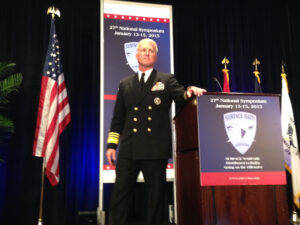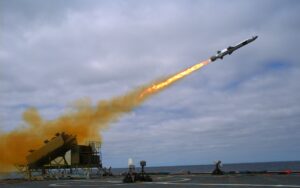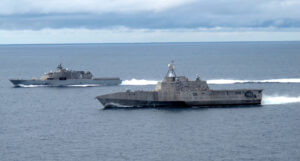‘If It Floats, It Fights’: Navy Seeks ‘Distributed Lethality’
Posted on
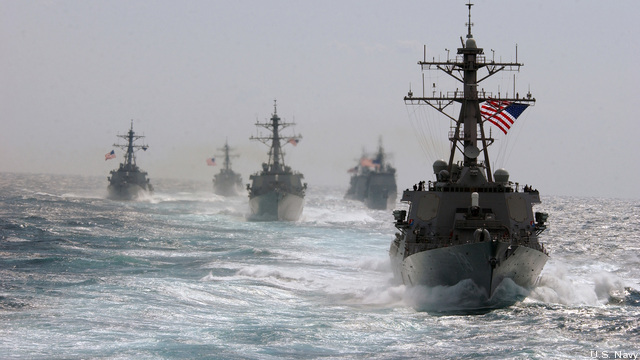
Aegis cruisers and destroyers.
CRYSTAL CITY: “If it floats, it fights,” Rear Adm. Peter Fanta says. “That’s ‘distributed lethality'[:] Make every cruiser, destroyer, amphib, LCS [Littoral Combat Ship], a thorn in somebody else’s side.”
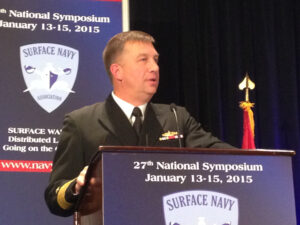
Rear Adm. Peter Fanta
“It just takes arming everything,” says Fanta, the director of surface warfare (section N96) on the Navy staff. “Lethality” simply means more and better weapons. “Distributed” means those weapons go on more ships, operating independently across a wide expanse of ocean to pose too many threats and too many targets for an enemy to cope with all at once.
While the Navy’s offensive ambitions are constrained by its budget, however, they’re still potentially revolutionary. After 20 years of playing mostly defensive supporting roles — carrier escort, ballistic missile defense, Tomahawk strikes on targets ashore — the Navy’s surface ships will take on a more independent and aggressive stance. That aggressiveness brings risk, especially in the face of well-armed adversaries such as China, especially for smaller and less robust vessels like the Littoral Combat Ship.
In wargames, says Fanta, “this is what we found: Without naming the adversary — you’re right, you lose some LCS in a full-up nation on nation war, [but] you put entire enemy fleets on the bottom of the ocean. Why? Because they come from everywhere and they’re all equipped with [anti-ship] weapons.”
Quantity, in other words, has a quality all its own.
What’s driving this new aggressiveness? The answer is that top Pentagon civilians and leading legislators are increasingly concerned about the Chinese and Russian threat. Now the US Navy’s getting the message. Just before Christmas, the Chief of Naval Operations announced an upgunned version of the low-cost, high-controversy Littoral Combat Ship, one with a yet-to-be-selected long-range anti-ship missile. This week, at the annual conference of the Surface Navy Association, Fanta and other admirals make clear they want to extend that model to the entire surface fleet. Though details are scarce until the president’s 2016 budget request comes out next month, the Navy will seek low-cost upgrades in weaponry and sensors to add offensive firepower to existing vessels, from Aegis destroyers to amphibious assault ships to, potentially, even supply ships.
“Why not think about putting offensive weapons on our combat logistics warships?” asks Vice Adm. Tom Rowden, who formerly held Fanta’s job and is now Commander of Naval Surface Forces. “The picture I’m painting is one of a surface force that is bristling with offensive capability, one in which a large number of ships cannot be ignored,” forcing the enemy to divide his attention and forces. Instead of an adversary being able to focus sensors and smart weapons on the one or two aircraft carriers the US can typically deploy to any given region at any given time, “distributed lethality” forces a foe to deal with dozens of destroyers, Littoral Combat Ships, and others, all armed with anti-ship weapons those classes lack today.
The new approach is, quite literally, about getting the most bang for the buck. While the Navy wants to develop a new long-range anti-ship missile to replace the outdated Harpoon, its first resort is to modify the hardware it already has and buy new hardware that already exists. (One example is the Norwegian Kongsberg missile recently test-fired off the Littoral Combat Ship Coronado).
“The budget’s coming down,” Fanta says. “Distributed lethality … is taking the budget that we have and making everything out there that floats more lethal.”
“There’s a huge feeling in some areas that we should [just] cut the number of ships that you’re building or own and make those ships perfect,” Fanta adds. This would produce a smaller fleet of “exquisite” high-capability warships like the Death Star in Star Wars. But Death Stars have a nasty tendency to blow up.
“If I get the wrong ship with the exquisite systems, I’m 15 years away from fixing it,” Fanta says, citing typical development timelines for a new class of vessel. But if the Navy buys a larger number of good-enough ships, the rapid acquisition process can upgrade them as needed to meet new threats. “If somebody has something on the shelf, I go buy it and I bolt it on,” he says. “We have proven we can do that inside of six months.”
“Not every platform has to possess the most exquisite sensor or the longest-range, most capable missile,” says Adm. Philip Davidson, the head of Fleet Forces Command. As well as distributing lethality, “we must distribute our costs. This requires a mix of high- and low-[end] surface combatants,” from the glitzy DDG-1000 to the unglamorous LCS.
The Navy’s plan to arm Littoral Combat Ships with long-range anti-ship weapons makes the relatively lightweight ships a heavyweight threat, the admirals argued. It’s the old line about the best defense — or, as Fanta put it, “first choice of any surface warfare officer is hit the bad guy first.”
The new approach will create some culture shock and awe within the Navy.
“We’ve got a generation of warriors — not just surface warfare officers — that have been pretty much at liberty to drive to any point on the ocean and deliver power-projection fires forward without worrying much about defense [against enemy anti-ship weapons],” said Davidson. “That’s closing quickly,” he said, citing “anti-access/area denial threats” in places as unlikely as the Black Sea. “Lethality isn’t just about range and explosive weight: [It] must include culture and approach.”
“We’re not talking about missiles and sensors alone,” agrees Rowden. “We’re talking about people, about developing a whole new generation of warfighters comfortable with detached operations.”
Independent operations by smaller ships are the founding legends of the Navy: John Paul Jone’s Bonhomme Richard in the Revolution, the frigate Constitution in the War of 1812. But since World War II, the top-priority mission for surface combatants has been escorting aircraft carriers, while long-range, independent operations increasingly became the preserve of nuclear-powered submarines. Then, once the Soviet Union and the budget fell, the Navy cost-consciously phased out much of its ability to fight an enemy fleet. Destroyers refocused on new missions like attacking land targets with Tomahawks and defending against ballistic missiles. In a major conflict, war plans and wargames assumed the surface ships would operate together with the carriers, protected by their onboard aircraft.
The new concept, by contrast, calls for “hunter-killer surface action groups” of three or four warships operating far beyond a carrier’s reach. When possible, these small squadrons will stay connected via the Navy’s new long-range battle networks, sharing threat and target data over such systems as Naval Integrated Fire Control – Counter-Air (NIFC-CA). But given adversaries’ progress on electronic warfare and cyber attack — jamming and hacking — they also need to be prepared psychologically and tactically to operate when the links go dead, said Rowden.
So while technology gets a lot of attention, “it’s a two-pronged approach,” Rowden told reporters. building on the work of his predecessor, Vice Adm. Thomas Copeman, Rowden is about to stand up a Top Gun-like new “Naval Surface Warfighting Development Center” (NSWDC) to devise new tactics and dispatch trainers to inculcate them across the fleet. This, he says, “is going to be a generational task.”
 The approach already has some backers on Capitol Hill. “Any new idea that breaks the surface Navy out of the defensive-first culture that has dominated its investments and planning the last two decades and brings more offensive-minded thinking to the table should be encouraged,” says one congressional staffer who works Navy issues.
The approach already has some backers on Capitol Hill. “Any new idea that breaks the surface Navy out of the defensive-first culture that has dominated its investments and planning the last two decades and brings more offensive-minded thinking to the table should be encouraged,” says one congressional staffer who works Navy issues.
Only an offensive mindset can keep the fleet relevant in the face of increasing threats, the staffer argues. “As we talk more about operating in mature precision-guided munitions regimes, it has become common to cite the demise of the surface Navy. I think what Rowden and Fanta are saying — and I tend to agree — is that this is nonsense and a fate we don’t have to accept,” the staffer says. “By developing new warfighting concepts for our surface fleet, we not only make use of the large force structure we have already invested in, but we can also drive the maritime competition in new directions that are advantageous to our interests. Instead of China or Iran setting the terms of the competition, we should be seeking to define it and searching for ways to impose costs and put them on their heels. “
Subscribe to our newsletter
Promotions, new products and sales. Directly to your inbox.

